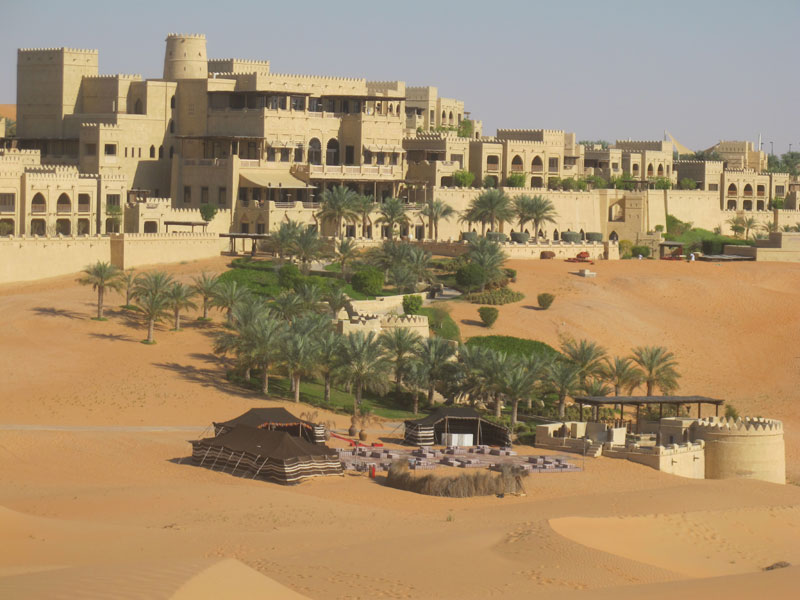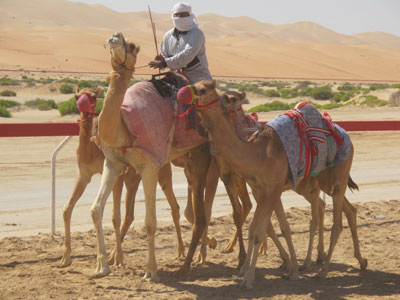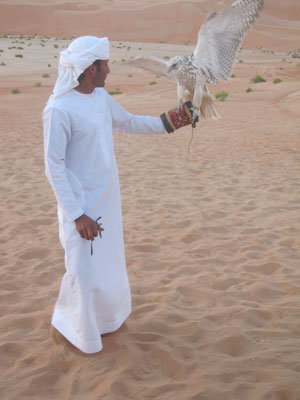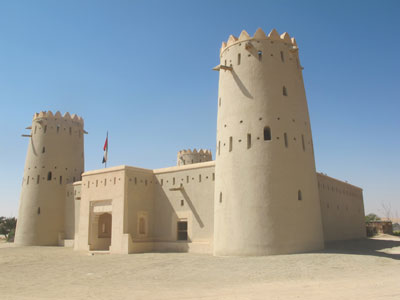Indulging in the ultimate desert experience in the United Arab Emirates
This article appears on page 34 of the January 2015 issue.
While on business in Dubai and Abu Dhabi in the United Arab Emirates in February 2014, I took advantage of the opportunity to indulge in the most luxurious desert experience I’d ever heard of. The experience was made all the more surreal as I watched, on television, the snowstorms and frigid temperatures ravaging the Midwest, where I live, while I was basking in the magnificent beauty of the desert.
Specifically, I spent several days at the Qasr Al Sarab Desert Resort (1 Qasr Al Sarab Rd.; qasralsarab.anantara.com), situated in one of the most astonishing landscapes in the region, the Liwa Desert. Part of the Rub’al Khali, better known as the Empty Quarter, Liwa is the world’s largest sand desert.
Qasr Al Sarab, which in English means Mirage Palace, was born out of the vision of Abu Dhabi’s leaders, who wished to celebrate the traditions and roots of the emirate. The resort was designed with a clear focus on Arabian culture and heritage. Perched on the shoulder of a dune overlooking a long natural valley that runs east to west for several kilometers, it was inspired by the architectural grandeur of the old forts of Abu Dhabi and Al Ain.
Getting there
My journey began with a 2½-hour drive from Abu Dhabi. The Empty Quarter — 620 miles long and 310 miles wide — occupies a portion of Saudi Arabia and spills over into small sections of the United Arab Emirates, Oman and Yemen.
I hired a private driver to take me from Abu Dhabi to the resort for approximately $100 (one way). I used the services of Hussain Said (abryrent@eim.ae), General Manager of Al Abri Rent A Car. His brother-in-law, Anas, who works for the same company, drove me back to the airport in Abu Dhabi at the end of my stay. They both were safe drivers and very prompt, and they charged reasonable prices, quoted in advance of each transport. (I also used their services in Abu Dhabi and Dubai.)
Their cost for the trip to Qasr Al Sarab was at least 50% less than the price quoted by the resort itself, which can arrange private transport for $230 one way.
As we drove farther into the desert and away from Abu Dhabi, the sand dunes became more majestic in height, and at about 30 minutes out from the resort we were completely enveloped by undulating dunes.
A private road veered off from the highway and, after a 15- to 20-minute drive, led us to a stately bridge nestled between high sand dunes. Beyond the bridge was a courtyard with the towering arched entrance to the resort’s reception area.
At check-in, I was served dates, mint tea and Arabic coffee. In the spirit of Arabic hospitality, these treats were available in the reception area at all times for guests and visitors alike.
About the resort
Qasr Al Sarab has 206 rooms, including 40 stand-alone villas that each have their own small, heated swimming pool. I stayed in the main part of the resort in a deluxe terrace room (a corner room on an upper floor) that included a very large bedroom furnished in traditional Arabic style, a magnificent bathroom with an enormous soaking tub and a separate shower, and a large rustic terrace with an incredible view of a 450-foot-tall sand dune.
I regret that I didn’t have 30-plus friends with me to enjoy my outdoor terrace, which was large enough to host a party with cushioned benches and tables and chairs with a view of endless sand dunes, but I did spend many an hour sitting outside gazing at the silent desert at different times of the day.
I had originally reserved a deluxe garden room, the least-expensive room at the resort ($565 per night during high season, November to Easter), but, after seeing that the hotel was not full, I inquired about an upgrade. To my surprise and delight, I was upgraded to the terrace room (usually $815 per night) at no additional charge.
The resort’s room rates included breakfast, a 10% service charge and a 6% tourism fee, which is attached to all hotel rooms in Abu Dhabi. The rates decrease by about one-third during the low/summer season, when temperatures can soar to over 130°F and average 115°F daily. During the high season, temperatures average a very comfortable 75°F during the day and 56°F at night.
About 50% of the guests visit Qasr Al Sarab as a result of business or government-related work in the UAE. For the other half, the resort is a vacation destination.
Transport within the grounds is provided by golf carts driven by hotel staff, though one can easily stroll through the sprawling resort on foot.
After I checked in, the hotel guide provided me with a tour of the property. When we reached the pool area, I decided to part ways, as there was a Mediterranean restaurant located on an adjoining terrace and it was a perfect time to have lunch.
This was my introduction to many meals to come at Qasr Al Sarab, and I was never disappointed. (This is a remark I make sparingly, having once been a freelance restaurant critic for a Chicago magazine.) I had gazpacho (AED50, or $14), which was very refreshing in the heat of the day, homemade tagliatelle with bolognese sauce (AED65), a mango-and-coconut parfait (AED45) for dessert and fresh pineapple juice.
Desert excursion
After lunch I headed over to the activities desk, located in the reception area, to book a number of excursions for the next several days. There were a variety of activities, including desert hikes; dune cycling or sailing; dune bashing; a desert safari by vehicle; camel treks at sunrise or sunset; archery; a falcon and Saluki dog show; horseback riding; a “night discovery” to view animals that emerge at night, and a visit to the traditional animals housed on the resort grounds.
For my first day, I took a 2-hour desert walking tour ($33 per person). There were only six guests on this excursion. This tour is available every day, departing at 10:30 a.m. or 4:30 p.m., when the sun is less intense. I had signed up for the late-afternoon excursion.
After a 20-minute drive from the resort over an ocean of sand dunes, we exited our vehicle and slowly hiked up a 300-foot-tall dune, making several stops along the way as we acclimated to “dune walking.” We took advantage of each rest stop to take photos of the dunes, which were beautifully framed by the deep-blue sky.
Scattered around the rolling sand hills were white salt flats and, surprisingly, a few blue watering holes or small ponds. We learned that the wind causes the dunes to migrate up to 12 feet per year.
The dunes come in magnificent shapes and many colors, from brown, tan and beige to hues of yellow, pink, red, purple and green. The colors of the dunes are transformed by minerals in the sand as well as the position of the sun.
At first blush, the desert’s extreme temperatures (particularly during the summer months) and the continuous flow of dunes, can be perceived as uninhabitable and unforgiving, but during my stay in the Empty Quarter I came to realize that these towering dunes echo with the stories of desert tribes that have roamed and settled there for centuries.
During our walk, we learned from our guide that an ability to read the intricacies of the dunes gave knowledge of which direction the wind was blowing, providing a navigational tool for the desert tribes.
Our descent down the dune to the vehicle was, needless to say, far easier than the climb up!
While in the vehicle, for a few fleeting seconds we saw two gazelles. We then drove to another area for sunset and watched as a bright-orange ball slipped behind the dunes.
A special evening
After returning to the resort and taking a brief rest, I was taken by golf cart to the resort’s outdoor restaurant, Al Falaj. During the cooler months of October to May, this restaurant offers a Bedouin-style dinner prepared by the hotel chefs. The meal and ambiance were outstanding.
There was a choice of either the traditional Arabic-style seating around a bonfire, sitting on comfortable cushions resting on the sand, with a small table in front of each cushion (which I chose), or Western-style seating with chairs and mini tables under an open-sided tent.
The first course featured a variety of mezzeh, including hummus; an eggplant dish; yogurt with cucumber; a chili paste, and other vegetable dishes. Next came several entrées, including Omani lobster (a real treat); jesh, a local white fish from the Persian Gulf; minced lamb with mint and onion; baby lamb chops; marinated chicken cubes; Oriental rice; baked potatoes, and okra in a stew of tomatoes, garlic, beans and onions.
There was a wide selection of Arabian pastries, pudding and fresh fruit to end the meal.
While all of the food was brought to the table, you could have unlimited portions of any of the dishes. Mineral water, soft drinks and juices were included in the price ($90); with alcoholic beverages, dinner cost a total of $125.
During dinner, a musician played a traditional instrument, adding to the atmosphere.
I gazed frequently at the abundance of stars above, as there was no industry or towns for miles around. It was a wonderful way to end my first day at Qasr Al Sarab.
Dates and dunes
On another day, I took a 5-hour tour of the oasis of Liwa that included a number of fascinating stops in the region. The guide/driver from the resort was extraordinarily informative and very personable.
Our first stop was Liwa Fort, built around 1860. From the ramparts of this small fort made of mud bricks and straw, I could see date farms in all directions. (Because Liwa has an abundant source of water, its economy is driven largely by date farming.)
Next we visited a camel farm and then the camel racetrack, to observe camels working out with a trainer, before continuing to two greenhouses in the area, one growing tomatoes and the other growing cucumbers. At a date factory, we enjoyed mouthwatering samples, including many types of candied dates, such as dates covered with chocolate.
Finally, we visited one of the highest sand dunes in the world, reaching approximately 280 meters, or over 900 feet, above sea level. Fortunately, we were able to drive to the top, where we had breathtaking, awe-inspiring views of dunes in all directions as far as the eye could see.
I never tired of viewing the dunes, given their endless varieties of shapes and sizes and the multitude of colors.
The Liwa tour was the most expensive activity offered by the hotel, costing about $135 per person, but this excursion provided a true understanding of traditional life in the region.
It should be noted that almost all of the activities offered by Qasr Al Sarab had a reduced price for children under age 12.
For a bit of adventure, I took a private, 1½-hour dune bashing tour ($80 per adult). For all dune bashing excursions, the resort always includes a backup vehicle in case any vehicle gets stuck while plunging down the sand dunes.
The scariest part of this “roller coaster” ride was driving on the side of the dune. I always felt as if the vehicle was going to tip over.
The staff advises that for this excursion, participants eat only a light meal or nothing at all immediately before the activity, as some people might experience motion sickness.
During my stay at the resort, I met people of many different nationalities but relatively few Americans. Many Americans do not view the United Arab Emirates as a vacation destination, yet UAE has some of the most spectacular hotels and iconic properties in the world plus one-of-a-kind dining experiences. One could easily craft a vacation in the UAE that includes spectacular sights in Abu Dhabi, Dubai, Al Ain and other smaller cites as well as desert and Persian Gulf excursions.
I travel to the UAE at least once a year on business and I had always wanted to experience the Empty Quarter. I am glad I was finally able to carve out time to make this travel dream come true.
I found the Empty Quarter to be magical, mysterious, serene and mirage filled. The tranquility of the desert, with its stunning scenery, plus the chance to stay at a luxurious desert palace added to the decidedly “Lawrence of Arabia” feel of my experience.




